Howdy, Stranger!
It looks like you're new here. If you want to get involved, click one of these buttons!
Quick Links
The 1848 “CAL.” Quarter Eagle - America’s First Commemorative Coin
In January of 1848 James Marshall, who was an employee of John Sutter, discovered gold in the race of a sawmill that was under construction. Sutter’s Mill was near Coloma, California, which is about 36 miles northeast of the state capitol, Sacramento. The men soon discovered additional gold deposits further upstream, and it was found that there was more gold in the area. Sutter and his men tried to keep their discovery a secret, but that was impossible. By spring dozens of prospectors were looking for gold with tools that ranged from a simple metal pan to a primitive trough-like device called a cradle.
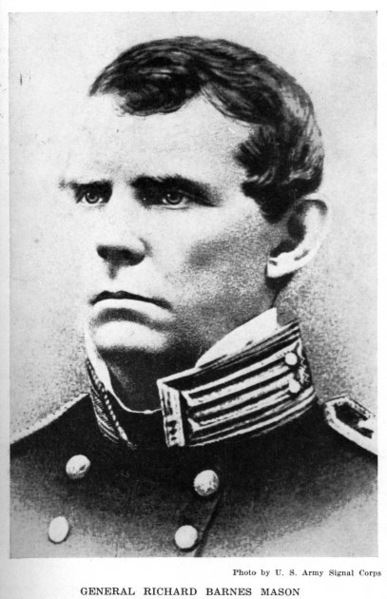
From Wikipedia
In Monterey, California Colonel Richard B. Mason, who was the military governor of the U.S. territory, viewed these developments with concern and interest. “Gold fever” had prompted many of the enlisted men in his unit to desert their posts and head for the gold fields in search of wealth. In addition, men who had been engaged in almost every profession from farming to office clerk had left their jobs “to strike it rich.” Mason decided that the time had come to report the news of the California discoveries to his superiors and provide them with some physical evidence of the gold strike.
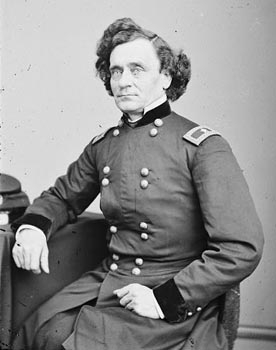
William T. Sherman in his youth ... from Wikipedia
In July Mason and his chief aid, Lieutenant William Sherman, selected four good soldiers and other support personnel and set out for the Sacramento Valley. Over the following weeks they purchased 13 samples of gold from the miners in the area and carefully marked on a map where those samples had been obtained. In August Mason combined those samples, with an “oyster can full of gold” that Mason purchased from the San Francisco Custom House for the depressed price of $10 an ounce. He packed the entire deposit into a tea caddy.
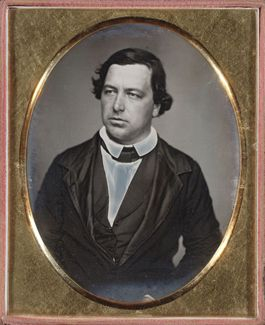
Lieutenant Lucien Loeser ... from Wikipedia
Mason selected Lieutenant Lucien Loeser to take the box, which contained 230 ounces of gold, to Washington, DC, and asked Lieutenant Sherman to write a report about the California discoveries. Sixteen years later Lieutenant William T. Sherman, by then a Union general, would emblazon his name into the history books with his famous, or for some, infamous "March to the Sea" across Georgia toward the end of the Civil War.
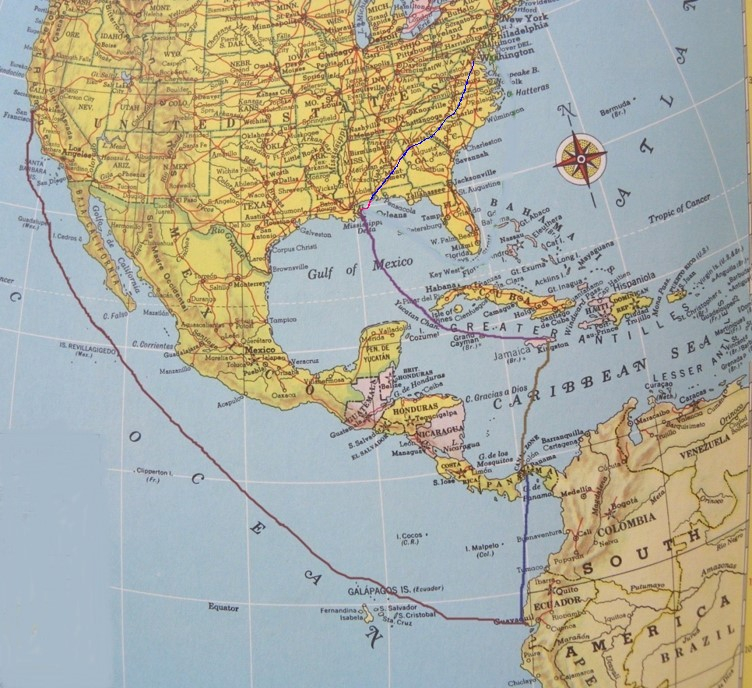
Lucien Loeser's probable route from San Francisco, California to Washington, DC
Lucien Loeser Begins and Long and Perilous Journey
Lieutenant Loeser set out for Washington, DC on August 30. The first leg of Loeser’s trip took him from San Francisco to Payta, Peru. There he boarded another ship that took him to Panama. After crossing the isthmus on horseback, Loeser boarded a ship on the Atlantic side of Panama and sailed to Kingston, Jamaica. There he booked passage on another ship to New Orleans, Louisiana.
Loeser probably took the quickest route to Washington, DC. That journey began by traveling by steamer from New Orleans to Montgomery, Alabama. From there he traveled on local coaches and railroads to central Georgia, probably Atlanta, and proceeded by rail to Washington, DC where he arrived on December 7. Overall the trip from the West Coast to Washington, DC had taken three months and one week.
“Gold Fever” Grips Washington, DC
Two days before Loeser's arrival, President James K. Polk announced in his annual message to Congress that, “Recent discoveries render probable that these (gold) mines are more extensive and valuable than was anticipated.” This statement combined with the display of the box of gold in Secretary of War, W.L. Marcy’s office set off a frenzy of interest.
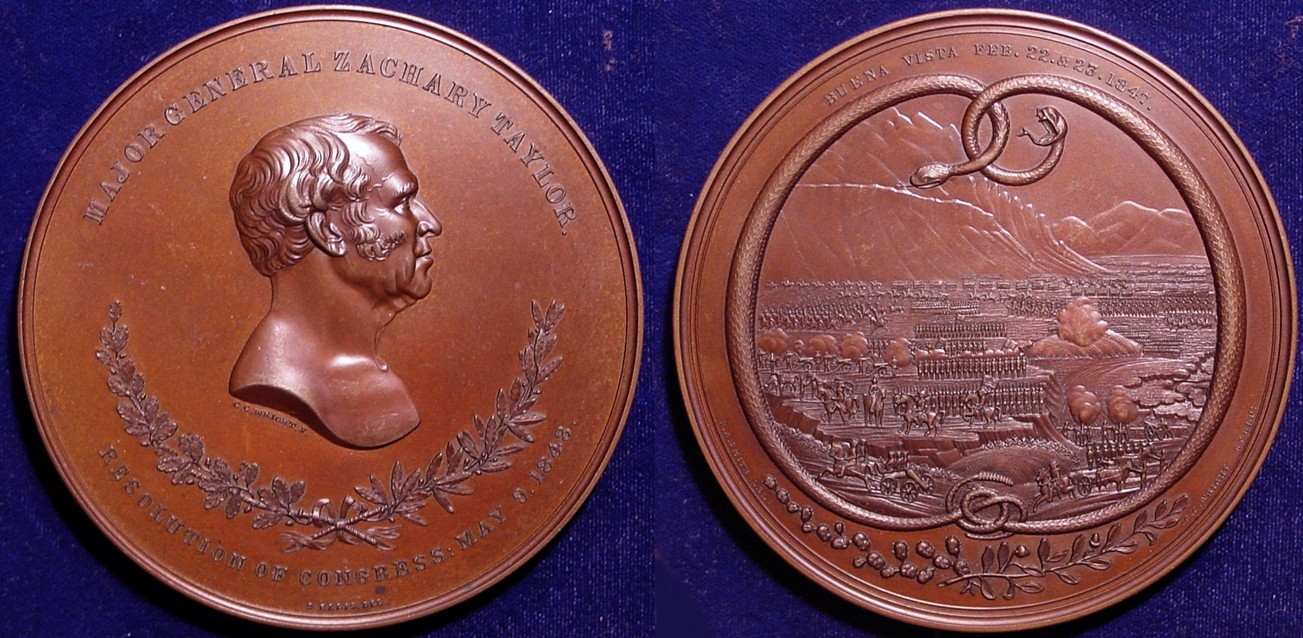
The Zachary Taylor Medal in Copper
War Secretary Marcy sent a letter to Mint Director R. M. Patterson in which he asked to the director to convert the almost 231 ounces of gold into two gold medals that would to be awarded to Mexican War heroes, Generals Zackary Taylor and Winfield Scott, one or two small gold bars, and some quarter eagles with a distinguishing mark. Marcy anticipated that some people would like to have a sample from the first gold shipment from California. He thought that citizens would be eager to trade ordinary gold coins to obtain the California quarter eagles at face value.
As it happened, a second gold shipment from California arrived a short time after Lieutenant Loeser delivered his chest. Gold from that second shipment was used to produce the two medals that were awarded to Taylor and Scott.
The Philadelphia Mint Processes the First California Gold Shipment
In the mean time the Philadelphia mint personnel began their assignment. As was quite often the case, the California gold contained silver that had to be parted from the body of the ore. After that the gold was alloyed with copper, it was formed into ingots and rolled into sheets from which the planchets were cut. After the coins were struck, there was one more step. Using the obverse coin die as an anvil, each coin was counterstamped with the letters “CAL.” above the eagle on the reverse. The use of the obverse die as an anvil prevented the flat spot that would have resulted on the coin had the counterstamp been applied on a smooth surface. This process was performed by a device known as a jig, which performs a repetitive procedure consistently.
As the year came to a close, Secretary Marcy was becoming impatient with the time it was taking to produce the quarter eagles. He sent his chief clerk, Archibald Campbell, to Philadelphia to investigate the situation. Marcy stated that if quarter eagles were ready, the mint personnel could hand them over to Campbell. Campbell returned to Washington empty handed.
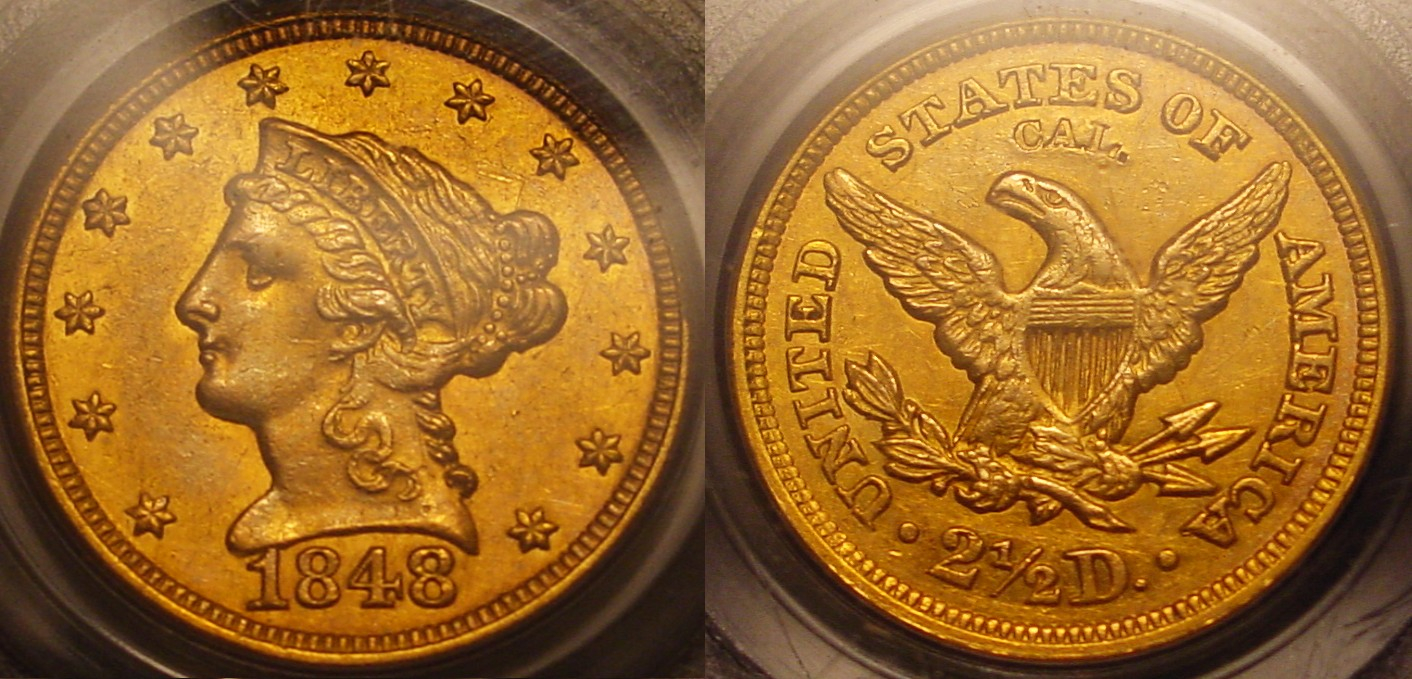
An 1848 CAL. $2.50 Gold Piece. PCGS graded AU-55
On January 5, 1849 Mint Director Patterson sent Secretary Marcy a letter that would confirm the importance of the 1848 CAL. quarter eagles for generations of coin collectors. Patterson stated that during the normal course of business the mint would have supplied the quarter eagles to a depositor as soon as the facility received the gold. In this case, however, Marcy had requested that the same gold that had been deposited was be used in the coins. This request had created the delay. The need to part the silver from the gold and apply the “CAL.” counterstamp had prolonged the process. At long last the coins were ready for delivery.
Although the mint did not record the mintage for the 1848 CAL. gold coins, it has been estimated from the available evidence that 1,389 pieces were produced. During this period, when there were only a small number of coin collectors in The United States, a limited number of the coins were saved. The vast majority of them went into circulation. It has been estimated that less than 200, perhaps no more than 160, of these coins survive today. Among that group less than 40 meet the standards for the Mint State grade.
A Collector’s Guide to the 1848 CAL. Quarter Eagle
The 1848 CAL. quarter eagle is one of the most desirable U.S. coins. Many numismatists view it as the first United States commemorative coin because it marked the receipt of the initial shipments of gold from California to a United States mint. In addition, the coin does not just commemorate that event. The coins were made from the actual gold that was shipped from California. No other U.S. commemorative coin has such a close relationship to the event that it marks.
To date NGC has graded 44, 1848 CAL. Quarter Eagles. PCGS has graded 77 examples which totals 121 pieces combined for both services. Among those NGC has graded 19 Mint State while PCGS assigned 25 pieces to that grade. As is the case with all population reports, there has probably been some double counting for coins that have been crossed over to one service or the other. There are also some pieces that have been graded by other services and an unknown number of raw coins that have never been graded.
Given these statistics, the 1848 CAL. Quarter eagle is a scarce coin, but not a rare one. Collector demand has been intense for many years, however, which has produced some impressive prices. Collectors who would like to add one of these historic coins to their collections can expect to pay a five or six figure price.


Comments
Congressional massive gold medals in
their highly ornate wood and gilt fixture cases are at the Smithsonian Inst. I have actually held each in my fingertips back in 1999